Dow hits new four-year high
The Dow has hit a new high. Can the market keep climbing? John C Burford studies the charts to find out.
I really enjoyed working with some readers at the MoneyWeek Trader workshop last week. We covered a lot of ground and it was great to see people picking up confidence in the strategy I follow.
In fact, later in today's post, we'll look at a trade we put on together during that session. It's a good example of what I look to do in my trading.
But first, let's see what's happening right now in one of my favourite markets, the good, old Dow
MoneyWeek
Subscribe to MoneyWeek today and get your first six magazine issues absolutely FREE

Sign up to Money Morning
Don't miss the latest investment and personal finances news, market analysis, plus money-saving tips with our free twice-daily newsletter
Don't miss the latest investment and personal finances news, market analysis, plus money-saving tips with our free twice-daily newsletter
Dow breaks above the old high
If you're closely following this market, you've probably already noticed the big news for chartists. Yesterday, the Dow poked above the 13,312 old high to reach 13,338.
When I last covered the Dow, the market was pushing back up after having broken my major uptrend line. It was attempting to kiss' the underside of that trendline.
Take a look at the updated daily chart to see how it's doing:
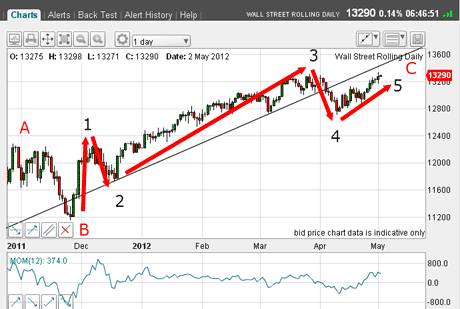
(Click on the chart for a larger version)
I've drawn in new Elliott wave labels, which have changed from my previous attempt.
The significant key to the change has been yesterday's new high. This confirms that the early April dip was a new wave 4 and we are currently in wave 5 of the larger C wave.
Trader tip: As I have often shown in these posts, Elliott wave counts are only definitive in hindsight! In real time, we have to make assumptions based on the information at hand at the time. This is just what occurs in real life, of course. I always had a question mark over the March highs was this a 3 wave or a 5 wave? If it was a 3 wave, I could expect waves 4 and 5 ahead. If it was really a 5 wave, I could then expect a resumption of the bear market. The difference for forecasting is immense!
What's important is that, although we have a new high, the market has still not touched the trendline! Let's keep this in mind.
OK, let's remove all the lines from the daily chart and start afresh. Here are my new lines which cover most of the highs and lows since summer.
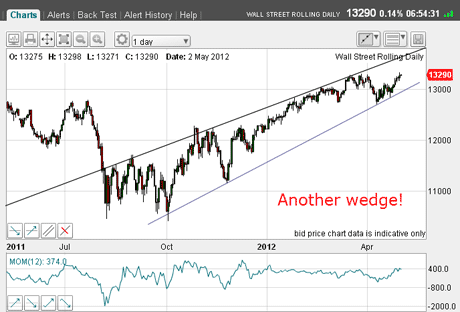
(Click on the chart for a larger version)
The only throw-over is on the 28 October spike. As you can see clearly, these lines describe a wedge pattern and are better than my previous attempt with more touch-points. I like them!
Remember, markets resolve up-sloping wedges downwards.
Now armed with this new wedge information, I can say that a break of the lower line would spell trouble for the bull market. Currently, this line lies at around the 12,700 area. This is also to be kept in mind.
My new tramlines highlight a potential upside target
But that is not all. I can now draw a new tramline set:
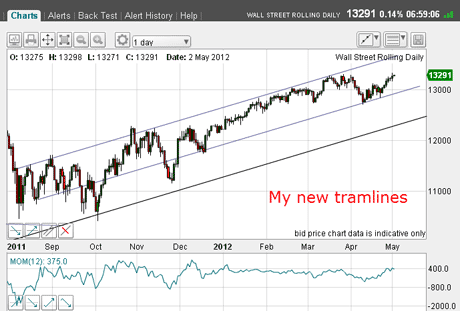
(Click on the chart for a larger version)
The touch-points on the two upper lines are very good. I am confident in using them.
That places the market around the centre of the trading channel between the central and upper tramlines a no-man's land on the daily chart. But the upper tramline is a possible upper target, of course and that lies in the 13,600 area.
So already, there is a 12,700 target from the wedge chart above, and a 13,600 target from the tramline chart. My head is spinning!
Key levels I'll be watching in the next few days
OK, let's zero in on the hourly chart and see if it gives us any clues as to direction:
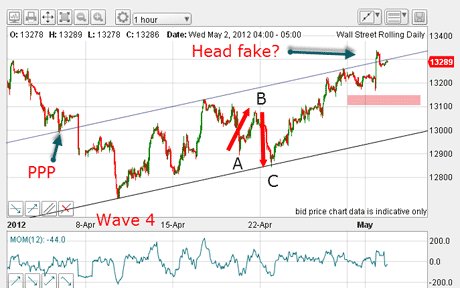
(Click on the chart for a larger version)
This is the hourly chart showing the wave 4 low and the current wave 5. Note the lovely A-B-C counter-trend correction, with the C wave landing precisely on my lower tramline.
The upper tramline sports a good prior pivot point (PPP). These are very pretty tramlines, and are the same ones I had in my 20 April post!
As I write, the market has poked slightly above the upper tramline and is deciding whether to carry on. Later this week the important US jobs data will appear, which could provide volatile conditions.
I have drawn in my pink bar under chart support. A move below could well herald a return to my lower tramline and a test of support there.
And a move below the wave 4 low would really get the bulls agitated!
But let us look again at my first chart:
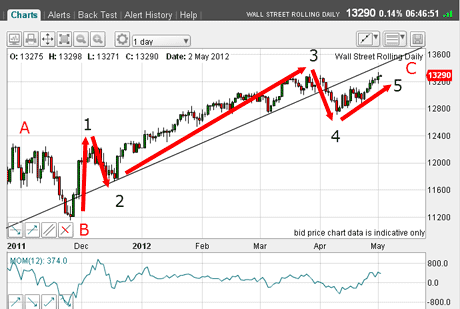
(Click on the chart for a larger version)
There is no negative momentum divergence between the 3 and the 5 waves. If we are near a top, I would prefer to see one.
This morning, it appears the market may stall here at the upper tramline of the hourly chart, but the larger trend still remains up. Let's see what unfolds.
In the meantime, I'd like to show you some other nice charts
The euro trade my students picked is looking good
Last Friday afternoon in the MoneyWeek Trader workshop, I invited everyone to choose a trade on a short-term chart. I asked them to explain it to everyone else using the tramline, Fibonacci, and Elliott wave ideas I taught in the morning session. I also asked for a target exit. No pressure there!
Luckily, everyone saw it as a challenge and set to work. It turned out that many had selected the five-minute chart of the EUR/USD. I guess it's a popular market!
This was the chart then:
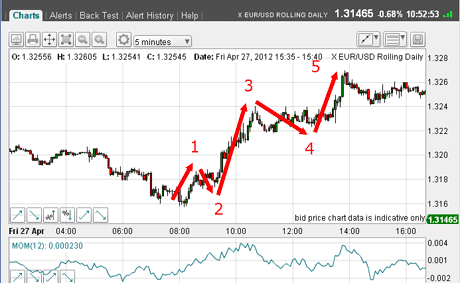
(Click on the chart for a larger version)
Many had spotted the lovely classic five-wave up-move and concluded that the top of the fifth wave was the likely top and it sported a negative momentum divergence between the 3 and 5 waves as a bonus.
We agreed that a short trade in the 1.3260 area was indicated, with a protective stop 30 or 40 pips above.
And this is how it is turning out as I write:
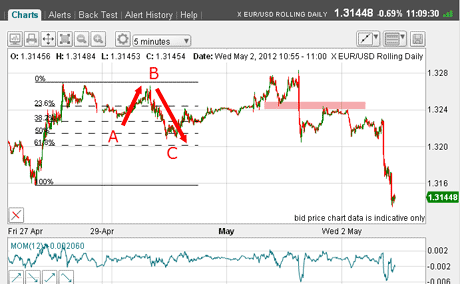
(Click on the chart for a larger version)
The 5 wave was indeed the top and the market then declined in a nice A-B-C with the C wave stopping right at the Fibonacci 50% retrace.
This was the target to take profits on the short trade if day-trading.
If I was trading on a longer horizon, an option would be to hold the short and if stopped out on the spike to 1.3280, re-enter on the break of the pink bar, which indicates chart support.
As I write, the open profit on the short trade is already 120 pips and I've moved stops to break even.
Where is the target now? I hope to have an answer very shortly. I'll be looking again at the euro soon in MoneyWeek Trader.
We covered an awful lot of ground in our workshop. It was great to see people getting stuck in and getting comfortable with using tramlines, Fibs and EW! I can't wait to see how the video we made of it turns out...
Don't miss Bill's next Daily Reckoning. To receive the next article straight into your inbox as soon as he's written it, sign up to the email list here .
Information in The Daily Reckoning is for general information only and is not intended to be relied upon by individual readers in making (or not making) specific investment decisions. Appropriate independent advice should be obtained before making any such decision. Your capital is at risk when you invest in shares - you can lose some or all of your money, so never risk more than you can afford to lose. Always seek personal advice if you are unsure about the suitability of any investment. The Daily Reckoning is an unregulated product published by Fleet Street Publications Ltd. Customer services: 020 7633 3600. Fleet Street Publications Ltd is authorised and regulated by the Financial Services Authority. https://www.fsa.gov.uk/register/home.do FSA number: 1152 34
Get the latest financial news, insights and expert analysis from our award-winning MoneyWeek team, to help you understand what really matters when it comes to your finances.
John is is a British-born lapsed PhD physicist, who previously worked for Nasa on the Mars exploration team. He is a former commodity trading advisor with the US Commodities Futures Trading Commission, and worked in a boutique futures house in California in the 1980s.
He was a partner in one of the first futures newsletter advisory services, based in Washington DC, specialising in pork bellies and currencies. John is primarily a chart-reading trader, having cut his trading teeth in the days before PCs.
As well as his work in the financial world, he has launched, run and sold several 'real' businesses producing 'real' products.
-
 NS&I cuts interest rates on 8 savings accounts
NS&I cuts interest rates on 8 savings accountsNS&I will now offer less attractive interest rates for customers wishing to lock their savings away to grow for one, two, three or five years.
-
 Investors will reap long-term rewards from UK equities
Investors will reap long-term rewards from UK equitiesOpinion Nick Train, portfolio manager, Finsbury Growth & Income Trust, highlights three UK equities where he’d put his money